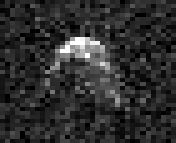(4660) Nereus
|
Asteroid (4660) Nereus |
|
|---|---|

|
|
| Radar image | |
| Properties of the orbit ( animation ) | |
| Orbit type | Apollo type |
| Major semi-axis | 1.4886 AU |
| eccentricity | 0.3599 |
| Perihelion - aphelion | 0.9529 AU - 2.0244 AU |
| Inclination of the orbit plane | 1.432 ° |
| Sidereal period | 663.4 days |
| Mean orbital velocity | 24.412 km / s |
| Physical Properties | |
| Medium diameter | 0.33 km |
| Albedo | 0.55 |
| Rotation period | 15.1 hours |
| Absolute brightness | 18.3 mag |
| Spectral class | SMASSII: Xe |
| history | |
| Explorer | Eleanor F. Helin |
| Date of discovery | February 28, 1982 |
| Another name | 1982 DB |
| Source: Unless otherwise stated, the data comes from JPL Small-Body Database Browser . The affiliation to an asteroid family is automatically determined from the AstDyS-2 database . Please also note the note on asteroid items. | |
(4660) Nereus is a near-Earth asteroid (planetoid) of the Apollo type .
The asteroid was discovered by Eleanor F. Helin at the Mount Palomar Observatory on February 28, 1982 and was named after Nereus , a titan and sea god in Greek mythology .
Nereus moves between 0.95 AU ( perihelion ) and 2.02 AU ( aphelion ) in around 1.8 years around the sun . The eccentricity of its orbit, inclined by 1.4 ° to the ecliptic, is 0.36.
The planetoid rotates around its own axis in 15.1 hours, the albedo of its surface is about 0.55 and its diameter is estimated at about 330 m.
Nereus is an attractive object for space missions, as it can be reached with a comparatively low expenditure of energy ( Delta v ). For this reason, it was the original destination of the Hayabusa Mission , which was scheduled to start in 2002. Due to a false start of the My-V launcher in February 2000, the launch of the space probe had to be postponed and a new target, (25143) Itokawa , had to be selected. Furthermore, Nereus should also be a possible target of the now canceled space probe Near Earth Asteroid Prospector .